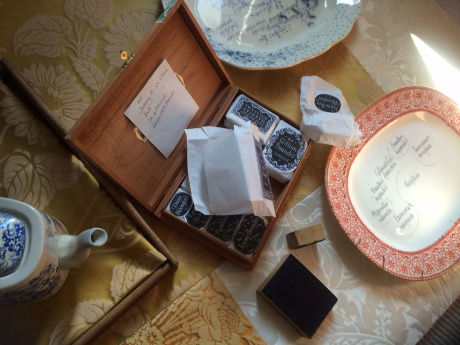‘Semi Permanent Collections’ by Emma Gregory
16 October 2015 – 2 April 2016
Victoria Gallery & Museum, Liverpool
Gallery 5, first floor galleries
The Victoria Gallery and Museum’s new temporary exhibition is a solo show by artist Emma Gregory.
Work began on the project three years ago when, whilst drawing in the University’s stored fauna collections following an invitation from Senior Curator Matthew Clough, Emma learned her father was ill.
The work in this exhibition has been selected from a larger body of prints, drawings and mixed media experiments made since – an eccentric mix of two and three dimensional pieces with a few of the University’s fauna specimen thrown in. Not what one might expect from Emma perhaps, who is best known locally for teaching printmaking at the Bluecoat.
It makes better sense when you learn that Emma worked in performing arts prior to her involvement in the Liverpool’s visual arts scene and also, briefly, as an upholsterer. And there is more than a whiff of theatricality about the three-dimensional work – take her daughter’s portrait, presented in buttons on a silk covered sandwich board or the ‘Costume for a Curator’ made using real birds’ nests. The nests were part of a natural history collection belonging to the artist. Other family collections have been incorporated into the show – silk and woollen damasks, postcards, buttons and her grandmother’s letterpress blocks, all beautifully engraved and carefully wrapped in printed papers.
It turns out Emma’s grandmother was an artist, Diana Bloomfield. She worked in the 1950s for clients such as Penguin and the OUP, producing intricately designed vignettes and illustrations. Emma has created new composite prints from the blocks she left behind – her own versions of their shared history.
Other two dimensional works include a series of photopolymer etchings such as ‘Life Cycle of a Jellyfish’. These largely monochrome prints have an archival look to them – the whole exhibition has a slightly Victorian feel. The prints repulse and attract in equal measure, as do the fauna specimens that hover in their glass jars nearby.
In the context of family loss and preservation – of collections and memories – the works in the show represent a meditation on the transient nature of existence. What we keep and what we cannot keep.
You can interact with Emma and her work through facebook and instagram and through her blog.
REVIEW:
Words by Patrick Kirk-Smith. Photographs by Patrick Kirk-Smith and artinliverpool.
An exhibition as widely appealing as this is a rare and refreshing sight. It ties in museology, fine art, print production, ceramics, millinery, design, local history, archival work, personal histories and genealogy in a small, very revealing show. Gregory makes the point in her explanation of the work that Facebook, blogs, YouTube videos and her own website is available for more information in what is a very modern exhibition, clearly understanding the value of continuation.
Continuation which is massively successful here, leading me to spend a lot of time trawling the internet for more information. The exhibition pins to one main theme, family history, something that grew from a project drawing Liverpool University’s heritage collections. After Gregory learned her father was ill the project shifted; it became a chance to take stock of her own heritage, preserving it for herself and for history’s sake.
There are some fantastic examples of preservation in the exhibition, as well as print responses created in her Bluecoat studio reflecting what most of us refer to as imprintingmemory. Initially I wanted to review this exhibition as a cabinet of curiosities, but had to change that when I realised how intertwined and tangled up in each other the works were. Each and every piece created or collected reflects elements of another object in the cabinet, or a story inspired by, or revolving around the object. It is a project of dedication and of love, and only in the final stages has skill had any part to play, producing beautiful objects in their own right, regardless of the story.
In a sense, the show can be simmered down to two main factors of print and archive, and in this case print is the act of creating an archive. Archive being a preservation, specifically a preservation of memory; and memory being fragile. These artefacts Gregory has created are, therefore, concrete, lasting, and documented in physical form, new memories, writing online and offline in what is one of the most thorough archives I have ever seen.
Work consists of everything from taxidermy to millinery, with notes of humour and notes of reflection, but somehow never feels cluttered. The cabinets are brimming with fascinating stories and the walls keep the show contemporary with Gregory’s confident photopolymer etchings, clearly demonstrating a mastery of print making despite theme or archive. As an autobiographical work to some extent, that element of value is freeingly forgotten, knowing that any work here is aimed at record keeping.

